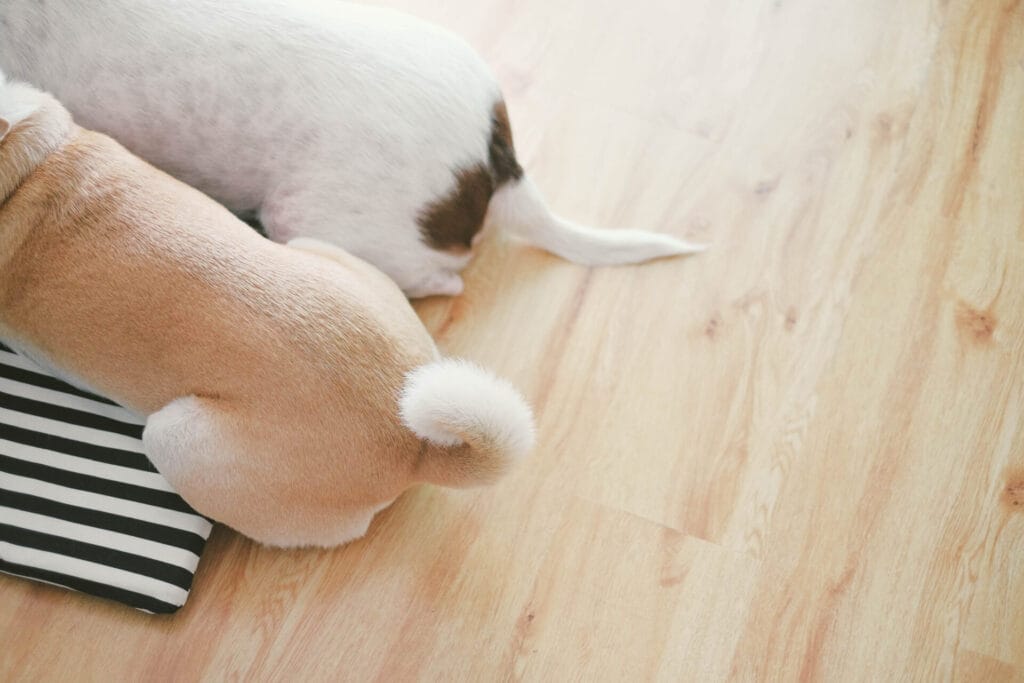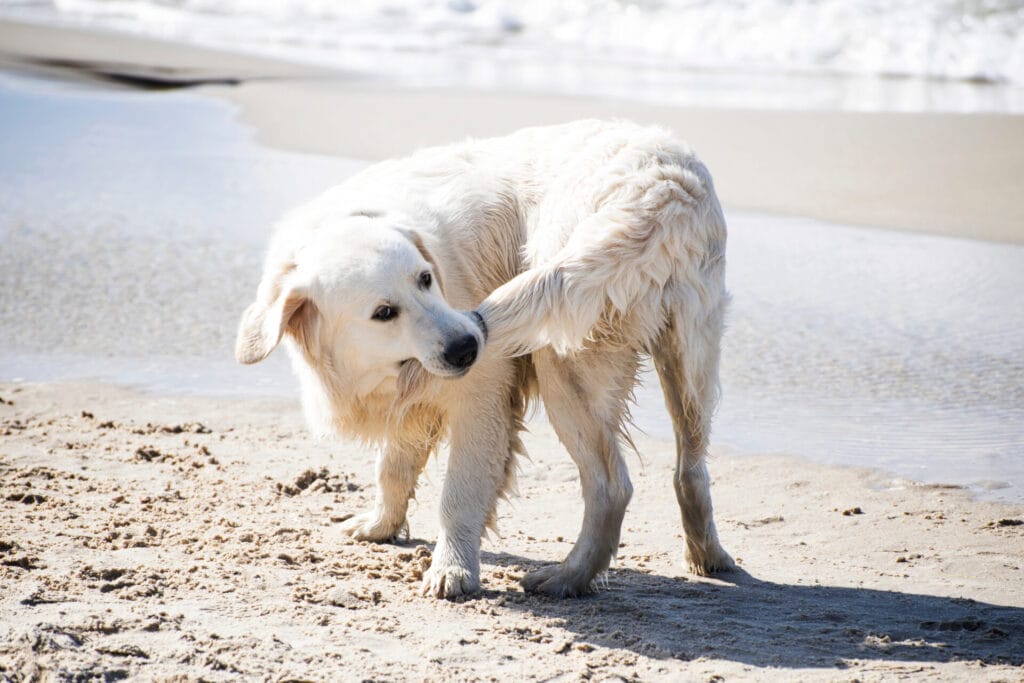Dogs are known for their wagging tails, which often signify joy, excitement, and happiness. A dog’s exuberant tail wagging occasionally leads to a condition: “Happy Tail Syndrome.” Although seemingly harmless, this condition can cause significant discomfort and complications for our furry friends. In this article, learn all about the causes, symptoms, and treatment options of Happy Tail Syndrome.
What is Happy Tail Syndrome?
Happy Tail Syndrome, also known as kennel tail or split tail, is a condition that occurs when a dog repeatedly strikes the tip of their tail against hard surfaces, leading to injury. This constant impact can cause open wounds, bleeding, inflammation, and pain. Since dogs often wag their tails enthusiastically—especially in tight spaces or against hard objects like walls, crates, or furniture—these wounds can be difficult to heal and may worsen over time.
Large, active breeds with long, heavy tails—such as Labradors, Great Danes, and Pit Bulls—are the most susceptible to Happy Tail Syndrome. Their strong, fast tail wags increase the risk of repeated trauma. However, any dog with a tail can develop this condition, particularly if they are excitable or live in environments with limited space.
One of the biggest challenges with Happy Tail Syndrome is that dogs continue to wag their tails despite the injury, causing wounds to reopen and prolonging the healing process. Since tails have limited blood supply and are constantly in motion, even minor injuries can take longer to heal compared to other body parts. If left untreated, repeated trauma can lead to chronic infections, severe tissue damage, and in extreme cases, partial tail amputation.
Early signs of Happy Tail Syndrome include small cuts or abrasions on the tip of the tail, persistent bleeding, scabbing, or excessive licking and biting at the tail. If you notice these symptoms, it’s important to take action quickly to prevent further damage and discomfort for your pup.
Causes of Happy Tail Syndrome
The primary cause comes from a dog’s tail repeatedly striking hard surfaces. The forcefulness results in the injury. Some common situations that can lead to this condition include:
- Tail Wagging. Dogs with exuberant wagging tails can inadvertently hit them against walls, furniture, crates, or other solid objects.
- Excitement and Activity. Dogs engaged in energetic activities and crowded environments may accidentally injure their tails.
- Confinement. Dogs confined to small spaces, such as crates or kennels, may repeatedly hit their tails when attempting to move.

Recognizing Symptoms of Happy Tail Syndrome In Dogs
Happy Tail Syndrome can be tricky to detect in its early stages, as dogs often continue wagging their tails despite minor injuries. However, as the condition worsens, you may notice the following symptoms, primarily affecting the tip of the tail:
- Open Wounds or Cuts: Repeated impact against hard surfaces can lead to small cuts, abrasions, or deeper wounds. These injuries may bleed, leaving traces of blood on walls, floors, or furniture.
- Swelling and Inflammation: The affected area may appear red, swollen, or tender to the touch, indicating irritation and possible bruising from repeated trauma.
- Pain and Discomfort: While some dogs may tolerate mild discomfort, others may whimper, yelp, or show reluctance to wag their tail. Sensitivity to touch in the tail area can also be a sign of pain.
- Frequent Licking or Biting at the Tail: Dogs instinctively lick or chew at painful or irritated areas, which can further aggravate the wound and delay healing.
- Infection Risks: If left untreated, open wounds can become infected, leading to pus, foul odors, or more severe swelling. An infected tail may also cause fever, lethargy, or a decrease in appetite.
Catching these symptoms early is crucial to preventing further injury and complications. If your dog shows signs of Happy Tail Syndrome, it’s important to take action by cleaning the wound, minimizing tail movement, and consulting a veterinarian for proper treatment.
Treatment Options
How To Treat Happy Tail Syndrome In Dogs
When dealing with Happy Tail Syndrome, it’s crucial to consult a veterinarian for a proper diagnosis and treatment plan. Since tail injuries can worsen quickly due to constant wagging, early intervention is key to preventing complications like infection or severe tissue damage. Depending on the severity of the injury, treatment may include the following:
Wound Cleaning & Infection Prevention
The first step in treatment is thoroughly cleaning the wound to remove dirt and bacteria. Veterinarians typically flush the injury with an antiseptic solution or specialized wound cleanser to reduce infection risk. In mild cases, at-home care with vet-approved antiseptics and regular cleaning may suffice, but deeper wounds require professional attention.
Tail Bandaging & Protection
Bandaging the tail helps protect the wound from further trauma while promoting healing. However, because tails are constantly moving, keeping a bandage in place can be challenging. A veterinarian may apply a padded wrap or recommend a specialized tail guard to provide additional protection. Proper bandaging should be snug but not too tight to avoid restricting blood flow.
Antibiotics & Infection Control
If there is an open wound or signs of infection—such as swelling, pus, or a foul odor—veterinarians may prescribe oral or topical antibiotics. Preventing infection is critical, as repeated trauma can lead to chronic wounds that are difficult to heal.
E-Collar or Tail Wrap to Prevent Licking & Biting
Dogs often lick or chew at their injuries, which can worsen wounds and delay healing. An Elizabethan collar (E-collar, also known as the “cone of shame”) or a soft tail wrap can help prevent self-inflicted damage. Some dogs tolerate a padded tail protector better than an E-collar, so veterinarians may suggest different options based on your dog’s comfort level.
Pain Management & Anti-Inflammatory Medication
Since Happy Tail Syndrome can be painful, veterinarians may prescribe pain relievers or anti-inflammatory medications to keep your dog comfortable. Managing pain is essential, as discomfort may cause a dog to wag less aggressively, reducing the risk of further injury.
Environmental Modifications & Prevention Strategies
In severe or recurring cases, making changes to your dog’s environment can help prevent future injuries. Providing cushioned bedding, limiting time in tight spaces, and discouraging excessive wagging near hard surfaces (such as crate walls or furniture) can minimize reinjury. Some pet owners even use foam tail protectors or special sleeves designed for tail injuries.
Preventing Happy Tail Syndrome In Dogs
Preventing Happy Tail Syndrome involves a combination of environmental adjustments, supervision, and proactive care to minimize the risk of repeated injury. Since this condition is caused by a dog’s tail repeatedly striking hard surfaces, the key to prevention is reducing the likelihood of trauma while ensuring your pup remains comfortable and happy.
One of the most effective preventive measures is creating a safe and spacious living environment. If your dog is prone to tail injuries, consider rearranging furniture to provide more open space and adding padded coverings to sharp edges or hard surfaces, such as walls, crate interiors, or kennel bars. Providing your pup with soft bedding and cushioned areas to rest can also help minimize tail injuries when they lie down or move around in confined spaces.
Supervising your dog during playtime and high-energy activities is another essential step. Dogs with powerful, excited tail wags—especially large breeds like Labradors and Great Danes—are more susceptible to injuries when playing indoors or in tight spaces. If your dog tends to wag excessively in excitement, consider redirecting their energy with mentally stimulating activities like puzzle toys or slow-paced training exercises that keep them engaged without excessive tail movement.

For dogs with recurring tail injuries, tail protection solutions such as padded tail wraps or protective guards can be beneficial. These coverings help absorb impact and reduce the risk of reopening wounds while allowing healing to continue. Some pet owners find that lightweight tail sleeves or foam wraps work well for dogs who don’t tolerate traditional bandages. If your dog frequently injures their tail in a crate or kennel, using a well-padded, larger crate with rounded corners may help prevent further damage.
In severe or chronic cases where other management strategies have failed, tail docking may be considered as a last resort. While this is a significant decision, some veterinarians may recommend partial tail amputation if a dog experiences repeated, painful injuries that lead to infections or persistent wounds. However, this step should only be taken after exploring all other preventive measures and discussing the risks and benefits with a trusted veterinarian.
By taking a proactive approach and making necessary adjustments to your dog’s environment and daily routine, you can significantly reduce the risk of Happy Tail Syndrome while keeping your pup safe, comfortable, and injury-free.



















